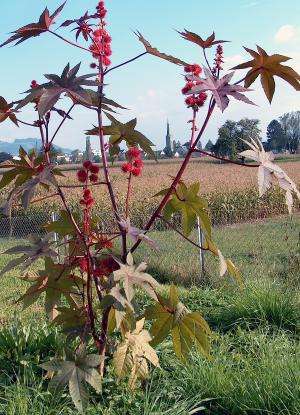Proteins in one of the world's main biodiesel plants have been mapped—and it does not look good

The castor oil plant produces some very fatty beans from which oil is refined into biodiesel in several countries, eg. Brazil. Now a team of researchers from the University of Southern Denmark along with researchers from Brazil have succeeded in mapping proteins of the bean, and thus it may now be possible to alter the bean's structure in order to get even more out of the bean than today. The researcher's work however shows that this may not be an easy task.
Countries like Brazil and India grow large quantities of the castor oil beans, which can be refined into bio-diesel. Unfortunately, the beans contain allergens and also the extremely potent poison ricin, and therefore the bean pulp after extraction of the oil cannot be used for animal feed. The animals might become sick or even die from eating castor pulp.
"Therefore we are interested in finding out if it in some way could be possible to eliminate the allergenic proteins and the ricin from the beans, so that the pulp can be used for animal feed", explains professor Peter Roepstorff, Department of Biochemistry and Molecular Biology at University of Southern Denmark.
The first step towards this has now been taken. Roepstorff and a team of Danish/Brazilian colleagues have used proteomics to map 1875 castor bean proteins.
"Now we know where the proteins are, and we know when during bean development they are produced. Especially the protein ricin and the allergen 2S Albumin are interesting in this context. Unfortunately our research shows that it does not seem to be easy to get rid of them", says Peter Roepstorff.
Both ricin and the allergen 2S Albumin are only present in low amounts in the early development stages of the bean. But as the beans mature, the content of ricin and 2S Albumin increases.
"Unfortunately, the mature beans also have the highest oil content and therefore an oil producer will not harvest the beans before they are fully mature. The price of optimizing the oil production is that you also get a toxic and allergenic pulp that cannot be used for animal feed", explains Peter Roepstorff.
The researchers at University of Southern Denmark work with identifying the bean's proteins and this now makes it possible for other researchers to try and manipulate the proteins in order to remove the toxic and allergenic substances. One option may be to eliminate the unwanted proteins by plant breeding, another option is to remove them by genetic engineering.
More information: Journal of Proteome Research, 3 October 2013 E-pub ahead of print: Isotope Labeling-Based Quantitative Proteomics of Developing Seeds of Castor Oil Seed (Ricinus communis L.): Fábio CS Nogueira, Giuseppe Palmisano, Veit Schwämmle, Emanuela L. Soares, Arlete A Soares, Peter Roepstorff, Gilberto B. Domont and Francisco AP Campos. pubs.acs.org/doi/abs/10.1021/pr400685z
Journal of Proteome Research, 2012, 11, 3046-3052: Performance of Isobaric and Isotopic Labeling in Quantitative Plant Proteomics: Fábio C. S. Nogueira, Giuseppe Palmisano, Veit Schwämmle, Francisco AP Campos, Martin R. Larsen, Gilberto B. Domont and Peter Roepstorff. pubs.acs.org/doi/abs/10.1021/pr400685z
Journal information: Journal of Proteome Research
Provided by University of Southern Denmark

















